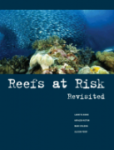-
Índice de Desigualdad Urbana (Index of Urban Inequality)
The main objective of the UII methodology is to estimate the level of accessibility/proximity to urban equipment for different socioeconomic strata in cities. This allows to compare and identify inequality in the territorial distribution of development opportunities such as formal employment,...
FORMATS: -
Global Map of Threat of Blast or Poison Fishing
This dataset was used as base data in Reefs at Risk. Map of blast and poison fishing (1 km grid) was developed for use in the Reefs at Risk Revisited project as a component of the model of overfishing and destructive fishing pressure on coral reefs. This layer designates threat of blast and...
-
Bleaching observations (1963-2010)
This dataset was used as base data in Reefs at Risk. Point locations of reported observations of coral bleaching between 1963 and 2010. This dataset was built upon an original bleaching database developed at UNEP-WCMC, and has been maintained and updated regularly by ReefBase since early 2002.
-
Tropical Coral Reefs of the World (500-m resolution grid)
Global map of shallow, tropical coral reefs, gridded at 500-m resolution for use in the Reefs at Risk Revisited project. The coral reef location data were compiled from multiple sources by UNEP-WCMC, the WorldFish Center, and WRI. To standardize these data for the purposes of the Reefs at Risk...
-
Marine Protected Areas in Coral Reef Regions of the World
This dataset is part of the base data used for Reefs at Risk Revisited. To assess the level of protection and management for coral reefs around the world. The map of MPAs and associated management effectiveness scores were used to adjust pressure from overfishing and destructive fishing in the...
-
Reefs at Risk Revisited (Social Vulnerability Data)
This shapefile features the Exclusive Economic Zones (EEZs) for 108 coral reef countries and territories classified according to an index of their reef dependence, adaptive capacity, and social vulnerability. Results are presented as quartiles, with 27 countries/territories classified in each of...
-
Average water consumption of livestock and wildlife by sub-basin in Kenya, 19...
WRI/ILRI calculation based on animal data from DRSRS 2003; Grunblatt et al. 1995, 1996; and daily water requirements for selected species from MoWD and JICA 1992, Peden at al. 2003, 2004. This data was used in Map 3.13 in Nature's Benefits in Kenya: An Atlas of Ecosystems and Human Well-Being.
-
Basins and sub-basins in Kenya
Calculations done by the World Resources Institute. This data was used in selected maps in Nature's Benefits in Kenya: An Atlas of Ecosystems and Human Well-Being.
-
Annual Projected Water Balance by Subdrainage Area in Kenya, 2000 and 2010
Calculations done by the World Resources Institute. This data was used in Map 3.7 in Nature's Benefits in Kenya: An Atlas of Ecosystems and Human Well-Being.
-
Existing small-scale irrigation and drainage points in Kenya
Data compiled by the International Water Management Institute (IWMI), Nairobi, Kenya. This data was used in Map 3.12 in Nature's Benefits in Kenya: An Atlas of Ecosystems and Human Well-Being.
-
Proposed large-scale irrigation schemes in Kenya
This data was used in Map 3.12 in Nature's Benefits in Kenya: An Atlas of Ecosystems and Human Well-Being.
-
Locations of water supplies serving Nairobi, Kenya.
Locations of dam were approximately located by WRI based on SoK 1971, MoWD and JICA 1992a, 1992b, 1992c, Nyaoro 1999, and Wambua 2003. This data was used in Map 3.9 in Nature's Benefits in Kenya: An Atlas of Ecosystems and Human Well-Being.
-
Water supplies serving Mombasa, Kenya
Locations of dam were approximately located by WRI based on SoK 1971, and MoWD and JICA 1992a, 1992b, 1992c. This data was used in Map 3.10 in Nature's Benefits in Kenya: An Atlas of Ecosystems and Human Well-Being.
-
Locations of proposed small micro-hydropower sites in Kenya
Locations of micro-hydro sites approximately located by WRI based on SoK 1971, and information from ITDG and ESDA 2005. This data was used in Map 3.11 in Nature's Benefits in Kenya: An Atlas of Ecosystems and Human Well-Being.
-
Locations of small micro-hydropower sites in Kenya
Locations of micro-hydro sites approximately located by WRI based on SoK 1971, and information from KenGen 2006, and Balla 2006. This data was used in Map 3.11 in Nature's Benefits in Kenya: An Atlas of Ecosystems and Human Well-Being.
-
Locations of large hydropower dams in Kenya
Locations of hydropower sites were approximately located by WRI based on SoK 1971, KenGen 2006, and from MoWD and JICA 1992a, 1992b, 1992c. This data was used in Map 3.11 in Nature's Benefits in Kenya: An Atlas of Ecosystems and Human Well-Being.
-
Tourist Accommodations in Kenya
Approximately placed by ILRI/WRI based on MacMillan Education Ltd. 1993, UNEP/GRID-Nairobi 1998, and RoK 1998
-
Number of beds by hotel on the eastern coast of Kenya
Number of beds calculated by ILRI and WRI, based on RoK 2003 and UNEP 1998. This data was used in Map 6.4 and Map 6.5 in Nature's Benefits in Kenya: An Atlas of Ecosystems and Human Well-Being.
-
Poverty data for Kenya, 1999
This data was used in Chapters 2 and 8 in Nature's Benefits in Kenya: An Atlas of Ecosystems and Human Well-Being in Kenya. Data are downloadable at www.planning.go.ke.
-
Minimum amount of Kenyan Shillings needed per sq km per month to close povert...
This data was used in Map 2.9 in Nature's Benefits: An Atlas of Ecosystems and Human Well-Being in Kenya.
